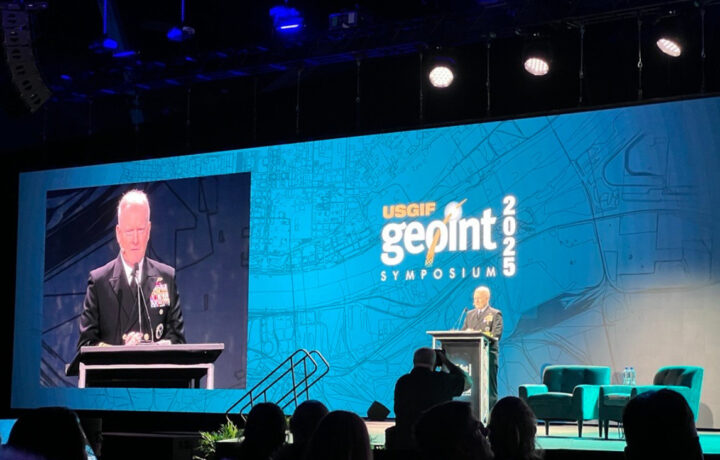At GEOINT 2025, Vice Admiral Frank “Trey” Whitworth, Director of the National Geospatial-Intelligence Agency (NGA), made it clear that space isn’t a new frontier for NGA—it’s a continuation of a mission decades in the making.
“Charting the surface of the moon led to the first lunar landing,” Whitworth reminded the room. “We’ve been in the space game for a long time.”
That legacy continued this morning with the signing of a formal Memorandum of Agreement (MOA) between NGA and the U.S. Space Force—a symbolic step that Whitworth called “just the warmup act” for what’s ahead.
A Mission That’s Bigger Than Earth
From disaster response to contested domains like the Indo-Pacific, NGA has had a year of high operational tempo—and even higher expectations. Whether supporting national security missions, humanitarian crises, or international partnerships, Whitworth emphasized that NGA has delivered intelligence at a pace and volume never seen before.
“We’ve done in weeks what used to take us years,” he said.
From seabed to space, NGA has extended its reach—and its role. And that includes strategic monitoring of China, support to NATO, partnerships in the Middle East (including a nod to Bahrain), and expanding academic and international collaboration.
NGA + AI: The Year of Transformation
2025, Whitworth declared, is officially “The Year of AI” at NGA. Following past themes like “Accelerate” and “Action,” this year marks a deliberate shift into what he called an “unchained phase” of AI transformation.
The progress has been tangible:
- Maven Smart System is now widely adopted across all services and combatant commands.
- User base for NGA’s AI capabilities has quadrupled in just a year.
- AI is helping shave hours off mission timelines—from sensing to engagement—and supporting faster decision-making in complex environments.
“But even with AI, it still requires trained humans,” Whitworth cautioned. “Technology can help—but interpretation and judgment still matter.”
To further spark industry partnership, NGA will host an AI Industry Day on June 9 at its Washington, D.C. campus. And looking ahead to 2026, Whitworth promised an even bigger leap forward.
Investment, Innovation, and Insight
Whitworth also spotlighted concrete investments NGA is making to support the mission, highlighting an URSA contract for unclassified GEOINT analytics, a University of Illinois contract for high-performance computing research, and an expansion contract with Palantir for Maven.
And behind every system, he reminded the audience, is a team. “It’s not about me,” he said. “It’s all the people doing the work.” In a brief but heartfelt exchange, Sue Gordon echoed the sentiment, “If you trust your women and men, you will never be disappointed.”
Charting the Future—Together
Whitworth encouraged everyone in the audience—whether from industry, academia, or government—to consider how they fit into this evolving GEOINT ecosystem:
- How can we harness proliferated architectures and commercial collection?
- How do international partnerships add strength?
- As our data grows, can our computational power keep pace?
He left no doubt: the drone story is just beginning, and so is NGA’s next chapter.
Full Circle in St. Louis
Whitworth brought it home with a historical reminder. Exactly 98 years ago, Charles Lindbergh completed the first transatlantic flight—and carried with him a single chart. That chart was created by a predecessor to today’s NGA, and it all began in St. Louis, MO.
“The world got smaller,” Whitworth said. “And NGA was part of it then, just like we are now.”
The Future Is Collaborative
From the lunar landing to real-time AI decisions, NGA has always helped define the edge of what’s possible. But this next phase—AI-fueled, data-driven, and globally integrated—demands more than capability. It demands collaboration.
As Whitworth put it, the MOA with Space Force isn’t the finish line. It’s the start.
And for the GEOINT community? “The time is now to build a secure tomorrow—together.”




